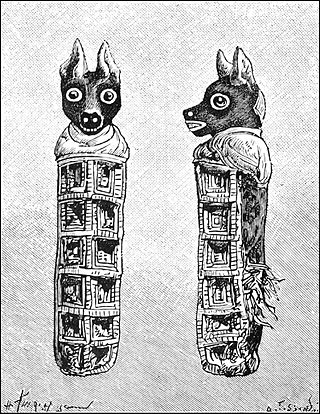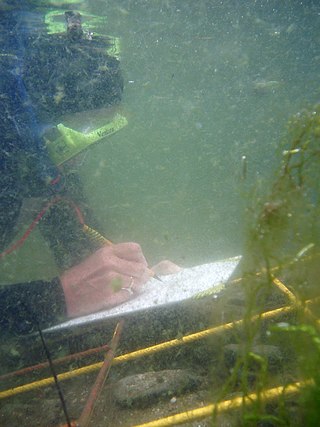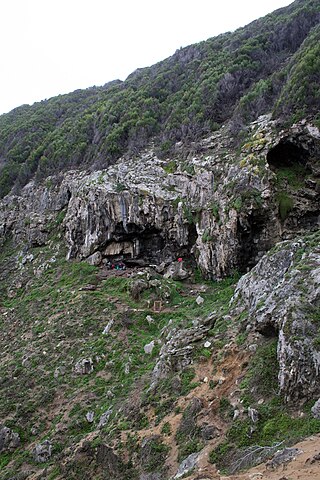
Zooarchaeology, also known as faunal analysis, is a branch of archaeology that studies remains of animals from archaeological sites. Faunal remains are the items left behind when an animal dies. These include bones, shells, hair, chitin, scales, hides, proteins and DNA. Of these items, bones and shells are the ones that occur most frequently at archaeological sites where faunal remains can be found. Most of the time, a majority of these faunal remains do not survive. They often decompose or break because of various circumstances. This can cause difficulties in identifying the remains and interpreting their significance.

Underwater archaeology is archaeology practiced underwater. As with all other branches of archaeology, it evolved from its roots in pre-history and in the classical era to include sites from the historical and industrial eras. Its acceptance has been a relatively late development due to the difficulties of accessing and working underwater sites, and because the application of archaeology to underwater sites initially emerged from the skills and tools developed by shipwreck salvagers. As a result, underwater archaeology initially struggled to establish itself as actual archaeological research. This changed when universities began teaching the subject and a theoretical and practical base for the sub-discipline was firmly established in the late 1980s. Underwater archaeology now has a number of branches including, maritime archaeology: the scientifically based study of past human life, behaviours and cultures and their activities in, on, around and (lately) under the sea, estuaries and rivers. This is most often effected using the physical remains found in, around or under salt or fresh water or buried beneath water-logged sediment. In recent years, the study of submerged WWII sites and of submerged aircraft in the form of underwater aviation archaeology have also emerged as bona fide activity.
Environmental archaeology is a sub-field of archaeology which emerged in 1970s and is the science of reconstructing the relationships between past societies and the environments they lived in. The field represents an archaeological-palaeoecological approach to studying the palaeoenvironment through the methods of human palaeoecology. Reconstructing past environments and past peoples' relationships and interactions with the landscapes they inhabited provides archaeologists with insights into the origin and evolution of anthropogenic environments, and prehistoric adaptations and economic practices.

Environmental studies is a multidisciplinary academic field which systematically studies human interaction with the environment. Environmental studies connects principles from the physical sciences, commerce/economics, the humanities, and social sciences to address complex contemporary environmental issues. It is a broad field of study that includes the natural environment, the built environment, and the relationship between them. The field encompasses study in basic principles of ecology and environmental science, as well as associated subjects such as ethics, geography, anthropology, policy, education, politics, urban planning, law, economics, philosophy, sociology and social justice, planning, pollution control and natural resource management. There are many Environmental Studies degree programs, including a Master's degree and a Bachelor's degree. Environmental Studies degree programs provide a wide range of skills and analytical tools needed to face the environmental issues of our world head on. Students in Environmental Studies gain the intellectual and methodological tools to understand and address the crucial environmental issues of our time and the impact of individuals, society, and the planet. Environmental education's main goal is to instill in all members of society a pro-environmental thinking and attitude. This will help to create environmental ethics and raise people's awareness of the importance of environmental protection and biodiversity.
Geovisualization or geovisualisation, also known as cartographic visualization, refers to a set of tools and techniques supporting the analysis of geospatial data through the use of interactive visualization.

In British law, an ancient monument is an early historical structure or monument worthy of preservation and study due to archaeological or heritage interest. The Ancient Monuments and Archaeological Areas Act 1979 classified ancient monuments as "scheduled monuments" or monuments that are considered by the Secretary of State of archaeological, historical or artistic importance.

Blombos Cave is an archaeological site located in Blombos Private Nature Reserve, about 300 km east of Cape Town on the Southern Cape coastline, South Africa. The cave contains Middle Stone Age (MSA) deposits currently dated at between c. 100,000 and 70,000 years Before Present (BP), and a Late Stone Age sequence dated at between 2000 and 300 years BP. The cave site was first excavated in 1991 and field work has been conducted there on a regular basis since 1997, and is ongoing.
Australian archaeology is a large sub-field in the discipline of archaeology. Archaeology in Australia takes four main forms: Aboriginal archaeology, historical archaeology, maritime archaeology and the archaeology of the contemporary past. Bridging these sub-disciplines is the important concept of cultural heritage management, which encompasses Aboriginal and Torres Strait Islander sites, historical sites, and maritime sites.

The archaeology of shipwrecks is the field of archaeology specialized most commonly in the study and exploration of shipwrecks. Its techniques combine those of archaeology with those of diving to become Underwater archaeology. However, shipwrecks are discovered on what have become terrestrial sites.

Capital Springs State Recreation Area is a state park unit of Wisconsin, United States, in development just south of Madison. The total area of the park is 3,000 acres (1,200 ha), with 326 acres (132 ha) designated as a state park. The park was authorized in 2000, the centennial of the Wisconsin state park system. The park includes 3,700 feet (1,100 m) of undeveloped shoreline on Lake Waubesa. The recreation area incorporates existing Dane County parks, and the site will be jointly managed by the state and the county.
Quaternary science is the study which represents the systematic study of the Quaternary Period commonly known as the ice age. The Quaternary Period is a time period that started around 2.58 million years ago and continues today. This period is divided into two epochs – the Pleistocene Epoch and the Holocene Epoch. The aim of Quaternary science is to understand everything that happened during the Pleistocene Epoch and the Holocene Epoch to be able to acquire fundamental knowledge about Earth's environment, ecosystem, climate changes, etc. Quaternary science was first studied during the nineteenth century by Georges Cuvier, a French scientist. Most Quaternary scientists have studied the history of the Quaternary to predict future changes in climate.
Wonderwerk Cave is an archaeological site, formed originally as an ancient solution cavity in dolomite rocks of the Kuruman Hills, situated between Danielskuil and Kuruman in the Northern Cape Province, South Africa. It is a National Heritage Site, managed as a satellite of the McGregor Museum in Kimberley. Geologically, hillside erosion exposed the northern end of the cavity, which extends horizontally for about 140 m (460 ft) into the base of a hill. Accumulated deposits inside the cave, up to 7 m (23 ft) in-depth, reflect natural sedimentation processes such as water and wind deposition as well as the activities of animals, birds, and human ancestors over some 2 million years. The site has been studied and excavated by archaeologists since the 1940s and research here generates important insights into human history in the subcontinent of Southern Africa. Evidence within Wonderwerk cave has been called the oldest controlled fire. Wonderwerk means "miracle" in the Afrikaans language.

The Holocene is a peer-reviewed scientific journal that covers research in the field of environmental studies, in particular environmental change over the last c. 11,500 years, particularly the interface between the long Quaternary record and the natural and human-induced environmental processes operating at the Earth's surface today. It is published eight times a year by SAGE Publications. The editor-in-chief is John A. Matthews.
The Journal of the Royal Anthropological Institute (JRAI) is the principal journal of the oldest anthropological organization in the world, the Royal Anthropological Institute of Great Britain and Ireland. Articles, at the forefront of the discipline, range across the full spectrum of anthropology, embracing all fields and areas of inquiry – from sociocultural, biological, and archaeological, to medical, material and visual. The JRAI is also acclaimed for its extensive book review section, and it publishes a bibliography of books received.
The Oxford Journal of Archaeology is a quarterly peer-reviewed academic journal published by John Wiley & Sons on behalf of the School of Archaeology, University of Oxford. It was established in 1982 and the editors-in-chief are Nicholas Purcell, Barry Cunliffe, Helena Hamerow, and Chris Gosden.
Australian Archaeology is a peer-reviewed academic journal published by the Australian Archaeological Association. It was established in 1974 and covers all fields of archaeology as well as other subjects that are relevant to archaeological research and practice in Australia and nearby areas. The journal uses a broad definition of archaeology to include prehistoric, historic, and contemporary periods and includes social, biological, and cultural anthropology, history, Aboriginal studies, environmental science, and other related areas. As of December 2021 the editors are Sean Ulm and Annie Ross assisted by associate editor Ariana Lambrides and book review editor Mirani Litster.
Science Publishing Group (SPG) is an open-access publisher of academic journals and books established in 2012. It has an address in New York City but is actually based in Pakistan. The company has been criticized for predatory publishing practices. As of 2019, it publishes 430 journals in various fields.







